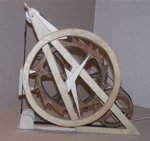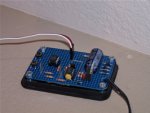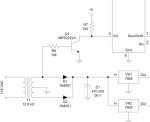It's a wooden clock with 2 gears. One for the minutes had and one for the hours. The gears are turned by levers wich are attache to a belt around some pulleys. The main pulley is turned by a rc servo.
A picaxe 08M converts the 60hz coming from the wall to a one minute pulse. Another 08M receives the one minute pulse and controls the servo.
I tried using a single 08M but because of the pauses required to let the servo travel a minute turned into 73 seconds.
A picaxe 08M converts the 60hz coming from the wall to a one minute pulse. Another 08M receives the one minute pulse and controls the servo.
I tried using a single 08M but because of the pauses required to let the servo travel a minute turned into 73 seconds.
Attachments
-
17.7 KB Views: 438
-
14.6 KB Views: 273



